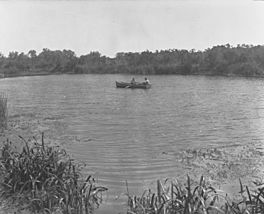Ewens Ponds facts for kids
Quick facts for kids Ewens Ponds |
|
|---|---|

Ewens Ponds, ca. 1945
|
|
| Location | South Australia |
| Coordinates | 38°01′36″S 140°47′26″E / 38.02667°S 140.79056°E |
| Type | Cenotes |
| Primary outflows | Eight Mile Creek |
| Catchment area | spring-fed water body |
| Basin countries | Australia |
| Max. length | Pond 1 - 50 metres (160 feet) Pond 2 - 38 metres (125 feet) Pond 3 - 19 metres (62 feet) |
| Max. width | Pond 1 - 32 metres (105 feet) Pond 2 - 38 metres (125 feet) Pond 3 - 28 metres (92 feet) |
| Average depth | Pond 1 - 9 metres (30 feet) Pond 2 - 9 metres (30 feet) Pond 3 - 13 metres (43 feet) |
| Max. depth | 13 metres (43 feet) |
| Water volume | Pond 1 - 28,000 cubic metres (990,000 cubic feet) Pond 2 - 212,000 cubic metres (7,500,000 cubic feet) Pond 3 - 4,400 cubic metres (160,000 cubic feet) |
| Residence time | Pond 1 - 6 hours Pond 2 - 3 hours Pond 3 - 1.5 hours |
Ewens Ponds are three amazing water-filled sinkholes in South Australia. They are like natural swimming pools formed in limestone rock. You can find them near Eight Mile Creek, about 25 kilometers (15.5 miles) south of Mount Gambier.
These ponds are super clear, so clear you can see up to 80 meters (262 feet) underwater! That's why they are a favorite spot for divers. You can also find special fish here, like the endangered golden pygmy perch. Since 1976, Ewens Ponds have been a protected area called the Ewens Ponds Conservation Park.
Contents
History of Ewens Ponds
The first people to live around Ewens Ponds were the Boandik group. They are part of the Bungandidj Aboriginal people. They lived in what is now south-eastern South Australia.
The first European to find the ponds was Thomas Ewens. He was hunting geese when his dog chased a kangaroo into one of the ponds. Ewens told the survey department about his discovery. That's how the ponds became known as Thomas Ewens Spring Ponds.
Over time, the land around the ponds was cleared. It was used for farming, especially dairy farming. A system was built to take water from the ponds. This water was used for farms given to soldiers after World War II.
In 1978, a trout farm started using water from Ewens Ponds. Even though the ponds are now a protected park, the farm still operates. Water for the farm comes from the second pond. Used water goes back into Eight Mile Creek, further downstream.
Geography and Formation
Each pond is a basin-shaped doline. This means it's a natural hollow in the ground. They are about 9 meters (30 feet) deep. Shallow waterways called "races" connect the ponds. The bottom of the ponds is covered with fine silt. The third pond also has a small natural cave.
The ponds are surrounded by a narrow strip of native bush. The rest of the land around them has been cleared. This area has a special landscape called karst topography. It forms when limestone rock slowly dissolves. This creates hollows, small caves, and deep sinkholes.
The water in the ponds is incredibly clear and fresh. Snorkelers and divers love swimming here. It's like being in a giant "underwater garden." You can easily see plants on the far side of each pond, even 80 meters (262 feet) away. Because the water is so clear, sunlight reaches the bottom. This allows plants to grow up to 6 meters (20 feet) tall!
Sometimes, the ponds have outbreaks of algae. This includes blue-green algae. However, tests have shown no health risks. In 2007, an environmental agency suggested why algae might grow. It could be from too much nitrogen in the water. This nitrogen might come from fertilizers, animal waste, or wastewater.
Amazing Animals of Ewens Ponds
Ewens Ponds is one of only three places where the golden pygmy perch lives. Many other fish also call the ponds home. These include short-finned eels, river blackfish, pouched lampreys, mullet, and common galaxias.
You can also find other creatures in the ponds. There are flatworms, freshwater crayfish, and mussels. The larvae of the carnivorous caddis fly also live here.
Fun Activities: Diving and Snorkeling
The Department of Environment Water and Natural Resources (DEWNR) manages Ewens Ponds. It is a conservation park. This means all plants and animals in the ponds are protected. You are not allowed to remove them.
Ewens Ponds is very popular with scuba divers. The water is super clear. There are rare and interesting fish, invertebrates, and plants. It's also a great place for underwater photography. Divers can even see photosynthesis happening! Aquatic plants release tiny bubbles of oxygen as they make their own food.
Divers must follow some rules to protect the ponds. They are not allowed to enter caves or cracks on the pond beds. Divers are also asked not to stir up the silt layer. This can make the water cloudy and harm the plants.
Divers usually start at the First Pond. They float with the current through the First Race to the Second Pond. Then they continue through the Second Race to the Third Pond. A ladder is there to help them exit the water. Some people try to swim upstream through the races. This can disturb the water plants. So, divers are strongly asked not to do this. The water temperature in the ponds is usually around 15°C (60°F).
Protected Area Status
Ewens Ponds and some nearby land became a protected area in 1976. It was named a conservation park under the National Parks and Wildlife Act 1972. This law helps keep the natural environment safe.


